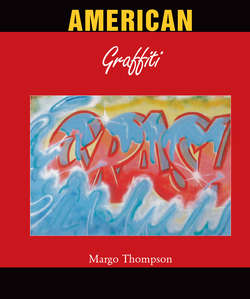Читать книгу American Graffiti - Margo Thompson - Страница 14
На сайте Литреса книга снята с продажи.
Subway Writers
NOC 167
ОглавлениеAccording to RAMMELLZEE, NOC 167 coined the phrase ‘style wars’, which conveys both the one-upmanship that existed among writers and the conflict over graffiti on the subways and other public spaces between writers and city authorities.[69] From the Bronx, NOC 167 began tagging in 1972 but quit in 1981, he said because his mother took a job in the federal government and if he were arrested for vandalism it would be an embarrassment to her.[70] Like DONDI, he adopted different tags to experiment with forms and combinations of letters, exhibiting creativity that inspired other writers. He also offered hands-on guidance: the Bronx writer CRASH said that aspiring writers could tell NOC their tags, and he would write them in two or three different styles to practice in exchange for a can of spray-paint.[71]
‘Style War’ was the title and theme of NOC’s whole car masterpiece from 1981. It was a complex composition, incorporating stylised lettering, abstract passages, and narrative elements. In the centre, ‘Style War’ was written in two distinct styles. ‘Style’ was composed of wild-style letters that waved and danced, elaborated with arrows directing energy and the viewer’s attention outwards. ‘War’ was in italicised block capitals. The letters were rendered primarily in black, white, and grey – some orange in ‘War’ tied it to the flames painted around it – and decorated with starbursts and dots of various sizes which added excitement to the restrained palette. These were known to writers as ‘pop and sizzle’, and were one of NOC’s trademarks that he had adapted from the comic book artist Jack Kirby.[72] Above the title was an abstract arrangement of white, blue, pink, and orange shapes, with dripping paint rendered in black. (Dripping paint was a sign of amateurism or lack of control of one’s medium and writers made every effort to eliminate it. Still, masters like NOC drew drips with paint in a self-reflexive gesture, much like Pop artist Roy Lichtenstein did with his comic book-style expressionist brushstrokes.) One side of the conflict was depicted to the left. A subway train shot out of the space from left to right, while a set of tracks with the perilous third rail came in parallel to the train at the top, from right to left. The space NOC articulated here was complex with two vanishing points far above and below the train. A guard tower anchored both spatial schemes while it existed in its own perspectival space to the left, where a horizon line was visible low on the end of the train car. ‘NOC 167’ against the train and ‘The Death Squad’ (the name of his crew) against the tower were situated in their own plane and made the symbolism of the scenario clear. On the right end of the car, two cartoon figures confronted each other: the one in a top hat seems to be shooting flames at the other one, a variation on the robot-assassin Necron99 from Ralph Bakshi’s animated film Wizards, who stood with one hand in a palm-up gesture.[73]
NOC’s subject was the dramatic life of the graffiti writer, who competes for dominance on a subway line and eludes the Metropolitan Transit officers who would persecute him for vandalism, and it was an exceptional treatment. The theme was rarely taken up on the subway cars themselves, where the risk involved in ‘bombing’ a train with a tag of any great ambition was implicit and familiar to the other writers who were the primary intended audience. When writers like NOC 167, DAZE, LADY PINK, and LEE worked on canvas for an audience of gallery-goers who might ride the subways infrequently if at all, they began to make their former lives as subway taggers their subject. This was in part to educate their new public, and to express their sense of themselves as authentically grounded in subway writing. This iconographical shift in the artwork, from tag to pictorial narrative, established a critical distinction between graffiti on the subway and graffiti in galleries. As graffiti artists, the writers adopted a self-reflexive point of view and consciously addressed an audience outside their peer group.
69
Edit DeAk, “Train as Book,” Artforum 21 (May 1983), 91.
70
Hoekstra, 190.
71
CRASH, lecture at the Brooklyn Museum, 1 July 2006. Podcast.
72
Villorente and James, 69.
73
Villorente and James, 69.
